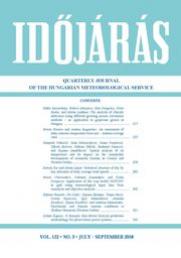IDŐJÁRÁS - angol nyelvű folyóirat
Vol. 122, No. 3 * Pages 217–361 * July - September 2018
 |
|
 letöltés [pdf: 4424 KB]
letöltés [pdf: 4424 KB]
The analysis of climatic indicators using different growing season calculation methods – an application to grapevine grown in Hungary
Ildikó Mesterházy, Róbert Mészáros, Rita Pongrácz, Péter Bodor, and Márta Ladányi
DOI:10.28974/idojaras.2018.3.1 (p. 217–)
Ildikó Mesterházy, Róbert Mészáros, Rita Pongrácz, Péter Bodor, and Márta Ladányi
DOI:10.28974/idojaras.2018.3.1 (p. 217–)
An assessment of daily extreme temperature forecasts – stations average view
Hristo Hristov and Andrey Bogatchev
DOI:10.28974/idojaras.2018.3.2 (p. 237–)
Hristo Hristov and Andrey Bogatchev
DOI:10.28974/idojaras.2018.3.2 (p. 237–)
Spatial analysis of air temperature and its impact on the sustainable development of mountain tourism in Central and Western Serbia
Danijela Vukoičić, Saša Milosavljević, Ivana Penjišević, Nikola Bačević, Milena Nikolić, Radomir Ivanović, and Bojana Jandžiković
DOI:10.28974/idojaras.2018.3.3 (p. 259–)
Danijela Vukoičić, Saša Milosavljević, Ivana Penjišević, Nikola Bačević, Milena Nikolić, Radomir Ivanović, and Bojana Jandžiković
DOI:10.28974/idojaras.2018.3.3 (p. 259–)
Statistical structure of day by day alteration of daily average wind speeds
Károly Tar and István Lázár
DOI:10.28974/idojaras.2018.3.4 (p. 285–)
Károly Tar and István Lázár
DOI:10.28974/idojaras.2018.3.4 (p. 285–)
Application of the crop model WOFOST in grid using meteorological input data from reanalysis and objective analysis
Hristo Chervenkov, Valentin Kazandjiev, and Veska Gorgieva
DOI:10.28974/idojaras.2018.3.5 (p. 305–)
Hristo Chervenkov, Valentin Kazandjiev, and Veska Gorgieva
DOI:10.28974/idojaras.2018.3.5 (p. 305–)
Bioclimatic and climatic tourism conditions at Zlatibor Mountain (Western Serbia)
Biljana Basarin, Tin Lukić, Dajana Bjelajac, Tanja Micić, Goran Stojićević, Igor Stamenković, Jasmina Đorđević, Tijana Đorđević, and Andreas Matzarakis
DOI:10.28974/idojaras.2018.3.6 (p. 321–)
Biljana Basarin, Tin Lukić, Dajana Bjelajac, Tanja Micić, Goran Stojićević, Igor Stamenković, Jasmina Đorđević, Tijana Đorđević, and Andreas Matzarakis
DOI:10.28974/idojaras.2018.3.6 (p. 321–)
A dynamic data-driven forecast prediction methodology for photovoltaic power systems
Kapros Zoltán
DOI:10.28974/idojaras.2018.3.7 (p. 345–)
Kapros Zoltán
DOI:10.28974/idojaras.2018.3.7 (p. 345–)
IDŐJÁRÁS folyóirat

Az IDŐJÁRÁS a HungaroMet Nonprofit Zrt. negyedévenként megjelenő angol nyelvű folyóirata
Megrendelhető a journal.idojaras@met.hu címen.
A szerzőknek szánt útmutató itt olvasható.
Megrendelhető a journal.idojaras@met.hu címen.
A szerzőknek szánt útmutató itt olvasható.









